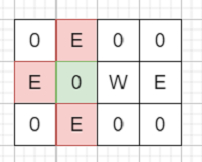
 Data Structure
Data Structure Networking
Networking RDBMS
RDBMS Operating System
Operating System Java
Java MS Excel
MS Excel iOS
iOS HTML
HTML CSS
CSS Android
Android Python
Python C Programming
C Programming C++
C++ C#
C# MongoDB
MongoDB MySQL
MySQL Javascript
Javascript PHP
PHP
- Selected Reading
- UPSC IAS Exams Notes
- Developer's Best Practices
- Questions and Answers
- Effective Resume Writing
- HR Interview Questions
- Computer Glossary
- Who is Who
Program to find maximum number enemies will be killed to place a bomb in C++?
Suppose we have a 2D matrix of three different values, 2s, 1s, and 0s, where a 2 represents an enemy, 1 represents a wall and 0 represents an empty cell. We have to find the maximum enemies we can kill using one bomb. The bomb kills all the enemies in the same row and column from the planted point until it hits the wall. And we can put bombs only on blank spaces.
So, if the input is like

then the output will be 3, as we can place the bomb at the green box to kill maximum 3 enemies.
ret := 0
n := row count of grid, m := column count of grid
Define an array colCnt of size m
-
for initialize i := 0, when i < n, update (increase i by 1), do:
-
for initialize j := 0, when j < m, update (increase j by 1), do:
-
if j is zero or grid[i, j] is same as 1, then:
rowCnt := 0
-
if grid[i, j] is same as 1, then:
k := j + 1
-
Otherwise
k := j
-
for k < m and grid[i, k] is not equal to 1, update (increase k by 1), do:
rowCnt := rowCnt + 1 when (grid[i, k] is 2), otherwise 0
-
if i is zero or grid[i, j] is same as 1, then:
colCnt[j] := 0
-
if grid[i, j] is same as 1, then:
k := i + 1
-
Otherwise
k := i
-
for k < n and grid[k, j] is not equal to 1, update (increase k by 1), do:
colCnt[j] := colCnt[j] + 1 when (grid[k, j] is 2) otherwise 0
-
if grid[i, j] is same as 0, then:
ret := maximum of ret and rowCnt + colCnt[j]
-
-
return ret
Let us see the following implementation to get better understanding:
Example
#include <bits/stdc++.h>
using namespace std;
class Solution {
public:
int solve(vector<vector<int>>& grid) {
int ret = 0;
int n = grid.size();
int m = n ? grid[0].size() : 0;
int rowCnt = 0;
vector<int> colCnt(m);
for (int i = 0; i < n; i++) {
for (int j = 0; j < m; j++) {
if (!j || grid[i][j] == 1) {
rowCnt = 0;
int k;
if (grid[i][j] == 1)
k = j + 1;
else
k = j;
for (; k < m && grid[i][k] != 1; k++) {
rowCnt += (grid[i][k] == 2);
}
}
if (!i || grid[i][j] == 1) {
colCnt[j] = 0;
int k;
if (grid[i][j] == 1)
k = i + 1;
else
k = i;
for (; k < n && grid[k][j] != 1; k++) {
colCnt[j] += (grid[k][j] == 2);
}
}
if (grid[i][j] == 0) {
ret = max(ret, rowCnt + colCnt[j]);
}
}
}
return ret;
}
};
main(){
Solution ob;
vector<vector<int>> v = {
{0,2,0,0},
{2,0,1,2},
{0,2,0,0}};
cout << (ob.solve(v));
}
Input
{{0,2,0,0},
{2,0,1,2},
{0,2,0,0}}
Output
3

